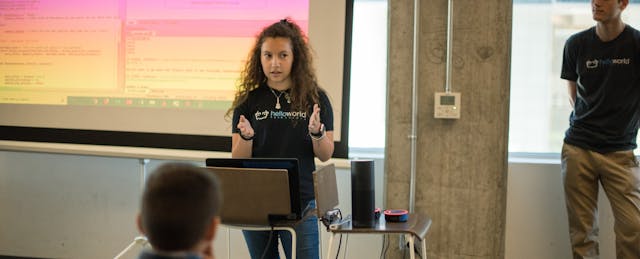Suguey Carmona, a 14-year-old Latina student, published her first “Alexa Skill” in the Amazon Appstore this year. Alexa is a virtual assistant developed by Amazon where users verbally ask questions and the AI responds with an answer. If you want to ask Alexa to do specific things, such as power on your Xbox or order a pizza, your Alexa has to have that “skill.” Suguey identified a skill that had not yet been created, so she decided to program it herself.
Suguey created a skill that allows English and Spanish-speaking immigrants to get answers to questions related to their rights. For example, users may ask Alexa, “Am I allowed to get my driver’s license?” or, “How long does it take to get a Visa?” The idea sprang from personal experience. When she saw her own parents struggle to find answers about their rights, Suguey decided to take matters into her own hands.
There is no doubt that this new Alexa Skill will help others, and that Suguey is well on her way to becoming a key influencer herself. The ability to design an Alexa Skill from scratch is something most developers do not learn until after college. The project required her to diagram and model immigration-related conversation outcomes and translate her model into programming logic. To implement her skill, she utilized JSON data formats, serverless architecture and localization to support Spanish users. Suguey was able to build her Alexa Skill through Hello World, a K-12 computer science program based in Austin and San Francisco, an organization I lead, that allows students to learn computer science skills that aren’t being taught in your average classroom.
Hello World seeks to empower young students with the computational thinking and problem solving capabilities to better navigate the growing high-tech industry. By working directly with tech professionals and connecting them with students, we hope to prepare the next generation of leaders in this space. And perhaps more importantly, we’re working to empower female and minority students with access to mentorship and learning opportunities in emerging computer science fields.
The continuing underrepresentation of students of color and women in computer science fields is a known issue of staggering consequence. An abundance of statistics point to the paucity of women and people of color in technology fields. In 2014, Google’s tech workforce was made up of only 17 percent women, two percent Latino/Hispanics, and one percent African-Americans. In 2013, among B.S. recipients in computer science fields, only four percent were African-American and five percent were Latino. In 2015, fewer than 10 girls of any race took the AP Computer Science exam in ten states, and not a single African-American student took the exam in nine states, including Mississippi, where 50 percent of high school graduates are African-American. Even among African-Americans, Latinos, and Native Americans who have STEM degrees, only 30 percent have STEM-related careers.
The influence of technology in the daily lives of Americans and those abroad has become increasingly ubiquitous. Shifts in technology directly impact our socioeconomic structures—how individuals contribute to society and make a living. According to the 2016 World Economic Forum (WEF)’s The Future of Jobs report, the “fourth industrial revolution,” which is described as the confluence of emerging technology breakthroughs (such as artificial intelligence, the Internet of things and 3D printing), are utterly transforming everything we experience and understand. And yet, these high-tech fields are dictated by privileged and powerful few, undoubtedly leading to significant blindspots and missed opportunities in our talent pipeline. While tackling this challenge at the professional recruitment level is an important approach, more radical measures are needed in the K-12 education space.

Various studies prove that female and underrepresented minority students are more likely than others to experience a lack of confidence in their abilities and imposter syndrome, meaning they believe that they have somehow not earned their achievements as a result of their own efforts or skills.
We know confidence is not borne in a vacuum. One’s belief that they are capable comes from experiences that affirm that belief, and the more rigorous and aspirational one’s accomplishments the stronger the fountain of affirmation to draw from. Undertaking a substantial computer science project provides students with tangible evidence that they can do the work of some of the most intellectually demanding fields in society. Other examples from students at Hello World include the creation of a virtual reality game built in Unity and C#, the publication of an iOS app that utilizes Apple’s augmented reality and machine learning platform to recognize and name objects in Spanish and Chinese and a music composition piece programmed in SonicPi and Ruby.
The focus on computer science as a means of empowerment has several added benefits. Computer science moves well beyond “coding,” a thin layer of software development that may make sense for immediate job seekers, but not for future innovators. In computer science, math and programming are utilized as sophisticated tools towards quantitative and logical reasoning where students can identify and analyze an abstract challenge or task, break this into smaller parts and develop and test solutions to solve one piece at a time—a valuable set of capabilities that can be applied to any field.
When cultural and societal norms continually feed to female and minority students that they belong in certain fields or cannot excel at certain tasks, a personal experience that demonstrates the opposite can be life-changing. This is what happened with Suguey. She used to think that she “wasn’t good enough” and now she knows that she is exceptional. This experience will serve as a continuous reminder that she can draw upon when faced with self-doubt, and the same could—and should—be true for many other students just like her.


